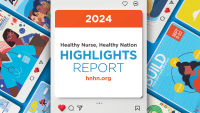Focus on safety and education.
- Gun injury has moved to the number one spot on the CDC’s list for causes of death in children between ages 1 and 19 years.
- Nurses and providers can make a difference in reducing firearm injury in their communities.
- Nurses should get involved in speaking out in support of local laws that will improve safety for their patients.
The 1980s and 1990s were full of neon bracelets, side ponytails, and kids playing in the streets until dark. Parents held babies on their laps in moving cars. My best friend and I raced our curly-handled blue and pink ten-speed bikes to school without helmets every day of junior high. My dad kept his loaded, unlocked handgun on a top shelf in the closet, and all six kids knew exactly where it was. It wasn’t that car seats, helmets, and weapons safety weren’t cool in the 1980s, they just weren’t considered a high-profile public health issue.
Over time, seatbelt use became more common with the enactment of laws about their use and babies now must travel in approved car seats. According to the Department of Transportation, automobile injuries plummeted by about 45% as seat belt use increased.
Gun violence: A public health issue
Addressing gun violence in America
Perspective: Mental illness and the right to bear arms
Pediatric gun deaths, however, haven’t decreased. Instead, they’ve increased at alarming rates since the 1980s. According to a Johns Hopkins Center for Gun Violence Solutions report in 2020 alone 15% more children died by gun violence compared to the prior year, the highest rate increase ever recorded. After the 2012 tragedy at Sandy Hook Elementary School in which a gunman killed 20 children and six adults, purchases of firearms immediately spiked by 3 million units. According to the Centers for Disease Control and Prevention (CDC), since the beginning of the COVID-19 pandemic, overall firearm mortality has increased by an astonishing 35%. Sadly, the CDC recently named firearm injury as the number one killer of children ages 1 through 19 years.
Healthcare workers’ role in gun injury prevention
Nurses and advanced practice providers educate parents on head injury and drowning prevention, car seat use, and sleep safety. We provide life-saving vaccines against polio, hepatitis, and measles. Unfortunately, we’re not discussing America’s number one killer of children. A 2022 study by Titus and colleagues revealed that, although most providers feel a responsibility to screen for proper storage of firearms in the home, only 3% to 13% of them actually have these discussions. That’s not surprising, given what a charged subject firearm safety has become.
Fortunately, the healthcare professional’s role isn’t to provide opinions about whether someone should own firearms. Instead, we promote health and safety education in conjunction with the understanding that the law supports a citizen’s right to bear arms.
The American Academy of Pediatrics has drawn attention to the role healthcare workers play in preventing gun injuries and has even published guidelines for discussions with patients and their families. We don’t have to limit these conversations to the primary care setting; we also can have them in hospitals and as part of emergency department discharge education.
We should ask families to secure any weapons in their homes and to keep ammunition separate from guns. We can provide information on local sources where they can obtain locks and security kits for their firearms. And we can encourage parents of young children and teens (especially those who have mental illness and may be prone to suicidal thoughts) to remove these weapons from the home.
Nurse educators and managers should commit to increasing patient and family gun safety education on their units and in their clinics. Primary care providers should include screening and education for gun safety during every wellness visit for children and adults. In addition, electronic health records should have the ability to incorporate screening methods into each chart, so that we can track and improve our interventions.
Low screening rates
A 2020 study found that one of the reasons behind infrequent firearm safety screening is that providers feel that they lack training in the subject and aren’t sure what they can legally discuss. After the introduction of the Dickey Amendment in the early 1990s, the CDC was prohibited from using annual budget funds to study the causes of gun violence. After protests by students who lived through the 2018 Marjory Stoneman Douglas High School shooting, in which 17 people died, legislators loosened some restrictions on gun research. In 2018, the Secretary of Health and Human Services announced that the CDC can perform limited research on causes of gun violence under funding from the annual Injury and Prevention Control budget, as long as they don’t promote any kind of gun control.
Some states have attempted to prevent providers from requesting information about personal weapons safety practices. A 2011 Florida law, The Firearm Owners’ Privacy Act, prohibited physicians from discussing gun ownership with patients. This law was overturned in 2017, and now no laws currently exist that prohibit safety counseling; however, medical workers still harbor some hesitation about screening as a result of these efforts and the current political climate.
Low screening rates also result from discomfort with broaching a subject that may make patients feel defensive. Trust plays a critical role in patient–healthcare professional relationships, so we must avoid the perception that we promote the removal of guns from owners or discriminate against those who own firearms. A partnership built on empathy and understanding of each family’s personal views can ensure that an effort to develop a home safety plan won’t damage that relationship.
Having the conversation
Aalsma and colleagues interviewed 104 gun owners to determine the most effective ways to discuss safety with families. Results of this qualitative study showed that messages that contextualize safe firearm storage within a general safety plan alongside car seat and helmet use, pool and water safety, and fire prevention were more positively received than those that focused on guns alone. In addition, study participants preferred messages from law enforcement and gun safety experts over advice from pediatricians. For this reason, a local professional organization’s firearm safety course may more effectively convey an injury prevention message. If patients express interest in firearm safety during an appointment, providers and nurses can offer information about enrollment in such courses.
To improve reception of education efforts, use the term “firearm” rather than “weapon” or “gun.” And don’t directly ask whether a family has a weapon in their home. Instead, general statements such as, “If you have a firearm in your home,” followed by educational information may present as more neutral than a line of direct questioning, which can feel like an interrogation. (See Firearm safety discussion tips.)
Firearm safety discussion tips
To make discussions about firearm safety less stressful, consider the following tips:
- Avoid directly asking whether patients or families have firearms in the home. Instead, use phrases such as, “If you have firearms in your home,” before providing safety education.
- Refrain from projecting a negative attitude toward firearm ownership and avoid political or personal statements.
- Focus on a message of safety and concern for children by including firearm safety information along with other similar topics such as wearing bike helmets, practicing water safety, using car seats, and testing smoke detectors.
- Provide local resources for low-cost or free gun locks. Project Child Safe (projectchildsafe.org) offers firearm safety kits at no cost and can direct families to the nearest locations in their state.
- Suggest that parents keep firearms unloaded and locked (either in a gun safe or with a trigger lock), and keep ammunition stored in a locked area away from the firearm. If the patient expresses concern about quick access, suggest biometric safes that allow easy access with a fingerprint scan.
- Provide information on local professional firearms safety courses.
Professional support
Medical professionals have long received accolades for the confidence they inspire in their communities and in the people they serve, so it’s entirely appropriate for nurses to use their trusted voices to call for changes to reduce injury, trauma, and death. The American Academy of Pediatrics and the American Nurses Association have each issued official statements calling for physicians, nurses, and nurse practitioners to support the removal of barriers that prevent research on pediatric gun violence, universal background checks, and mandatory waiting periods for gun purchases.
Children and adults who’ve been identified as in a current mental health crisis or have experienced domestic violence require specific attention, which can be addressed via cooperation between providers and local law enforcement. In addition, we need reporting avenues to prevent abusers and those at risk for suicide from having unrestricted access to firearms. The National Association of Pediatric Nurse Practitioners (NAPNAP) has gone even further; in addition to supporting universal background checks and 72-hour mandatory waiting periods, the organization also has requested that Congress address the overwhelming need for mental health services for children who’ve been affected by violence.
The weapons used in nearly all recent mass shootings could quickly fire multiple bullets, making them exponentially deadlier. NAPNAP has called on Congress to “limit the sale of high-capacity magazines” and “enact a federal ban on the sale, importation, or transfer of modifiers that convert firearms to act like semi-automatic or automatic weapons.” The American Academy of Family Physicians has recommended that healthcare workers use their voice to promote the funding of studies to identify evidence-based firearm safety measures, improve enforcement of gun laws, support Second Amendment–sensitive laws that limit the sale of high-capacity magazines and their counterpart firearms, and increase funding for mental health.
If you’re so inclined, make your voice heard. A quick Google search of your voting district or of “town meetings near me” will reveal community locations where you can speak out. Attend these meetings and ask what community leaders are willing to do to combat this public health crisis. Find your state’s legislative branch, and perform a search to locate pending bills for healthcare or guns and attend hearings for those that interest you (some allow virtual participation). Take one or two of your nurse friends along for support.
Our responsibility
The multifaceted causes of gun violence require more than the healthcare field to solve, but we can address patient safety in our corner by increasing education. Our responsibility lies in providing effective safety guidelines to our communities, and that includes distributing messages that involve firearm safety. Gun violence is a public health issue. We’re obligated to have neutral discussions with parents and patients that will encourage families to take measures to protect the lives of children, and we must offer our professional support to communities that will lead to broad changes for improvement.
Corinne Dixon is a pediatric float pool nurse at Honor Health in Scottsdale, Arizona, and a DNP-NP candidate at the University of Arizona in Tucson.
American Nurse Journal. 2024; 19(3). Doi: 10.51256/ANJ032412
References
Aalsma M, Keys J, Ferrin S, et al. Adolescent suicide assessment and management in primary care. BMC Pediatr. 2022;22(1):389. doi:10.1186/s12887-022-03454-4
American Academy of Nursing. American Academy of Nursing’s statement firearm safety and violence prevention. October 26, 2022. bit.ly/45frgiR
American Academy of Family Physicians. Gun violence, prevention of (position paper). 2018. bit.ly/3UhRlM6
American Nurses Association. ANA 2023 Membership Assembly passes urgent recommendations to address gun violence as a public health issue. June 17, 2023. bit.ly/3Hwnbx4
Centers for Disease Control and Prevention. Firearm deaths grow, disparities widen. June 6, 2022. cdc.gov/vitalsigns/firearm-deaths/index.html
Centers for Disease Control and Prevention. Leading causes of death and injury. November 8, 2023 cdc.gov/injury/wisqars/leadingcauses.html
Hinnant A, Boman CD, Hu S, et al. The third rail of pediatric communication: Discussing firearm risk and safety in well-child exams. Health Commun. 2021;36(4):508-20. doi:10.1080/10410236.2019.1700883
John Hopkins Center for Gun Violence Solutions. A year in review: 2020 gun deaths in the U.S. April 28, 2022. bit.ly/3vSpGr5
Lee LK, Fleegler E, Goyal MK, et al. Firearm-related injuries and deaths in children and youth: Injury prevention and harm reduction. Pediatrics. 2022;150(6):e2022060070. doi:10.1542/peds.2022-060070
Levine PB, McKnight, R. Firearms and accidental deaths: Evidence from the aftermath of the Sandy Hook school shooting. Science. 2017;358(6368):1324-8. doi:10.1126/science.aan8179
National Association of Pediatric Nurse Practitioners. NAPNAP position statement on prevention of firearm violence and injury in children. January 12, 2023. bit.ly/3Ohkgfw
National Highway Traffic Safety Administration. Seat belts. nhtsa.gov/risky-driving/seat-belts
Titus SJ, Huo L, Godwin J, et al. Primary care physician and resident perceptions of gun safety counseling. Proc (Bayl Univ Med Cent). 2020;35(4), 405-9. doi:10.1080/08998280.2021.2004532
Key words: gun injury prevention, firearm safety, safety, injury prevention, pediatrics



















1 Comment. Leave new
#ThisIsOurLane was healthcare’s response to a National Rifle Association tweet https://x.com/NRA/status/1060256567914909702?s=20. As a behavioral-health APRN who works with Veterans and children & adolescents, I routinely screen for access to firearms and lethal weapons; in fact, safety-planning for Veterans includes offering a firearm lock (i.e., distance and time). I understand from a therapeutic vantage the stigmatizing power of words. However, from a shared-decision-making vantage, informed-consent requires an understandable explanation. A friend of mine took his own life with a fatal GSW to the chest, and his best friend kept asking “where did he get the gun?”